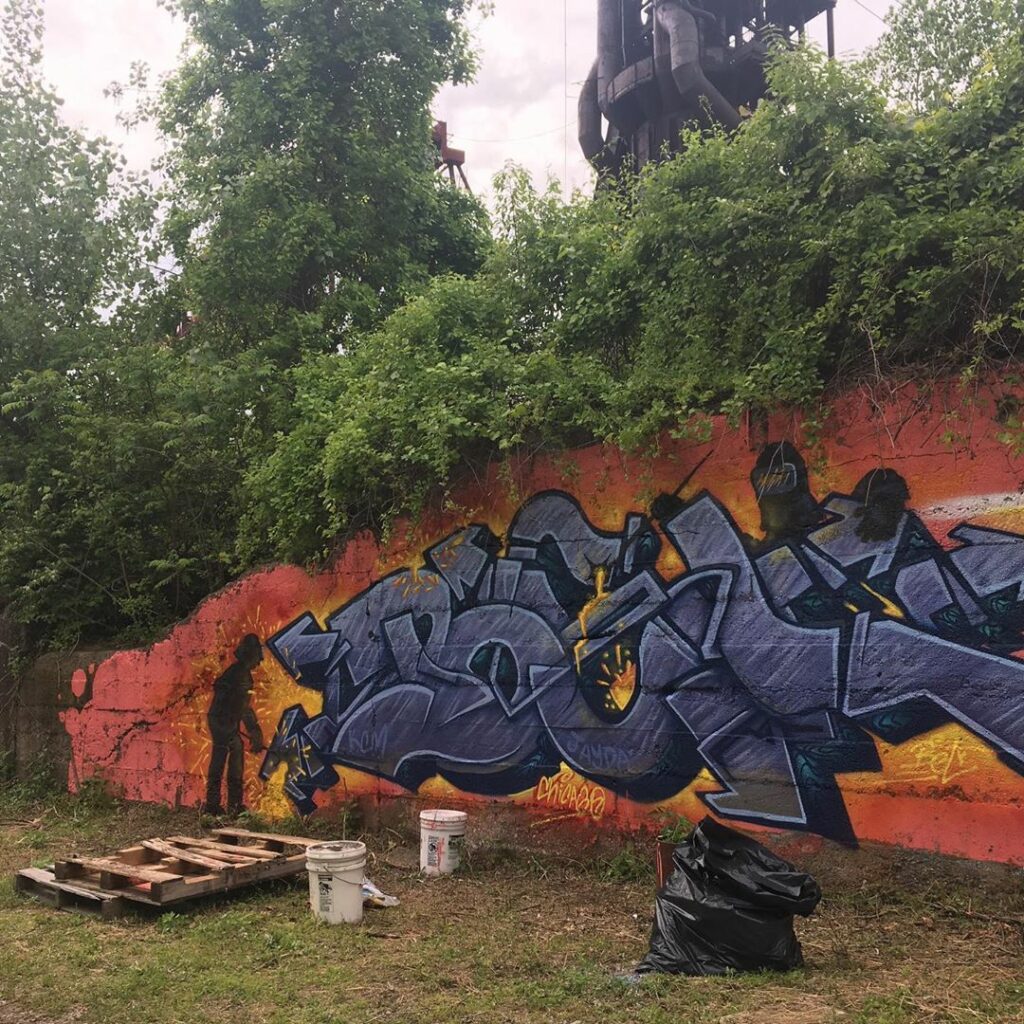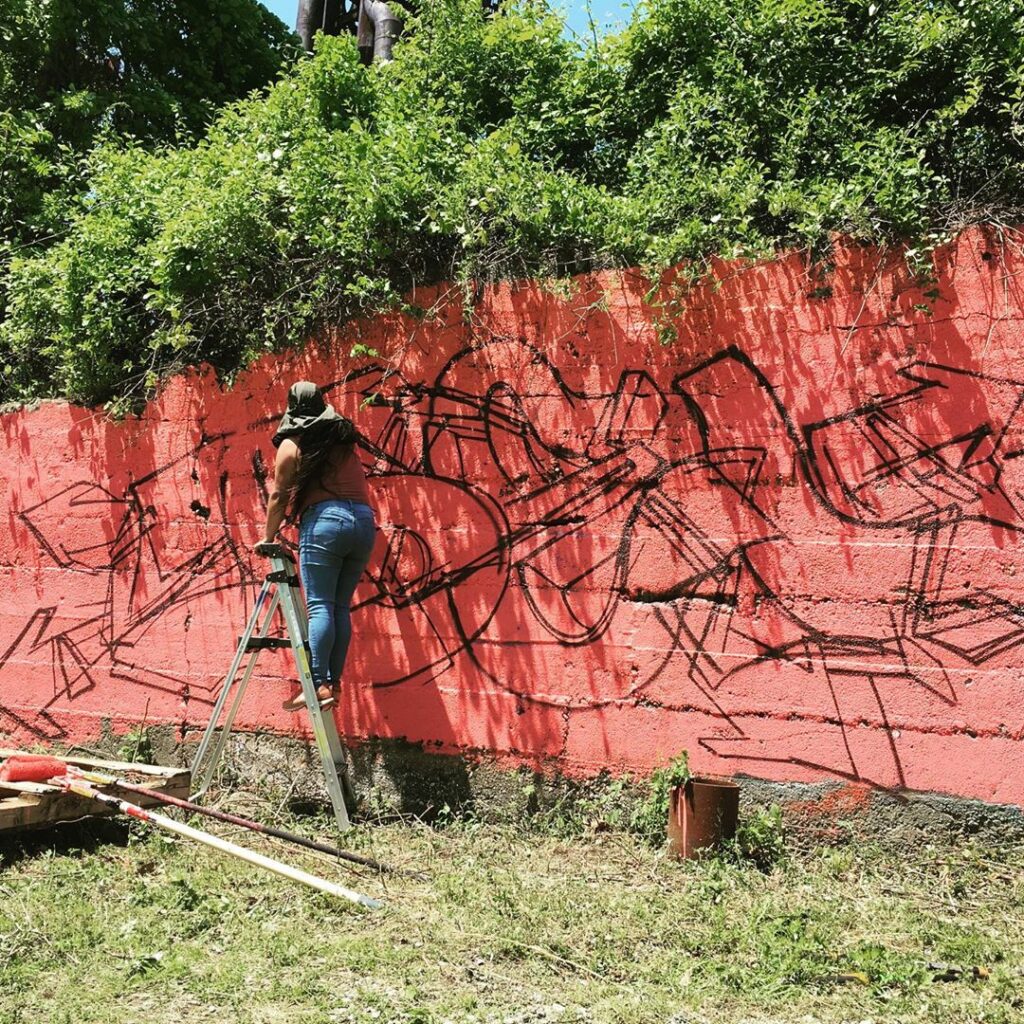These past couple weeks Hemispheric Conversations Urban Art Project (HCUAP) has hosted two visiting artists. One is from León Guanajuato, Victor Ayala Kart, and the other is from Chicago, Bel2.
I had the chance to do a quick interview with Bel about her experience in between paint sessions. She created an amazing piece at the Carrie Furnaces and was about to do another piece at 233 E 8th Avenue in Homestead. In our discussion she reflected on the ways that the history of the Furnaces inspired her work– an homage to labor and hard work. She also expressed her hope that people encountering her work could see how graffiti involves hard work and dedication, something that becomes visible when you look just a little more closely. Thanks, Bel, for gracing the Burgh with your amazing work!

CB: Can you tell me again your name and when you started painting?
B: My name is Bel and I started painting in 1990
CB: Can you tell us a little bit about the evolution of your style?
B: the evolution of my style I think is…oh man I don’t know its about so much as you get older it keeps changing but I’ve had a lot of mentors growing up and I think it’s a combination of my mentors, Kane was one of my mentors, I took a class with him…DD or Dedzo, I had a tattoo apprentice under him and he is also a writer. The biggest thing I learned from him was going big. Always go big. So, I think throughout these different experiences my style has been evolving. Now it is kind of curvy and straight, but I like to create a nice flow between my letters and so I always try and create connections and so it has evolved through different experiences with different artists…so just big and bold, not as wildstyle but still a little wild.
CB: Medium wild
B: Yeah, un poquito.
CB: Can you tell us a little big about how you approached your mural, your piece, at the Carrie Furnaces?
B: Before I got here I googled and did some research on the furnaces, and what the place was.
CB: Awesome.
B: Yeah and I was so excited as soon as I started watching the videos on it… the tour and the history that they were giving and just how its so many people working. And so when I was painting I wanted to kind of bring that out in my piece by making my letters kind of look like shiny steel…which I think I got kind of mixed up a little with the steel, iron, all of that, but, and having workers there so I added two workers— which could represente anybody, you know, because they all wore the same uniform, and so I wanted to put at least two people on there poking through my piece so that the hot metal would come out and so I really wanted it to represent the hard work that happened in there. Because there was so much hard work. And so many crazy hours were worked there. Its like they lived there. It was crazy. So, I was thinking a lot about the history and trying to push all that through my piece.

CB: And what was it like being in the actual space of the Furnaces?
B: Oh, it was overwhelming. It was really, really, dope. Just walking the grounds and knowing, because I had done some research so I knew what certain spaces were meant for already, so walking through them and actually seeing it…just something in the atmosphere there was like a ghost city kind of because so many people were in there at one point, that space was up and living. Hardcore. All day and all night. So to be there now where there was [almost] nobody there it was a little like tripped out. But I really liked it because there was so much history there and you are getting to walk the same space that so many people did and so many different cultures it was really surreal. It was really dope. I tried to take a lot of pictures and videos so I could like share that at home with my sister and my friends, but it was a really dope experience. It was really really humbling and it was nice. All this hard work went into it. And then I found out it was the smallest one [furnaces], too. And I was like oh shit this place is huge, and its one of the smallest ones. It was a really cool experience.
CB: Is there anything else you want to say about the pieces you have for the pop up exhibit tonight? Those pieces are pieces I have been working on on and off for a couple years now. One of them is specifically my name and my throw up and its just a combination of bel throw ups and on top of that is a more solid piece. To me, that represents how I started out as a bomber and I did a lot of that, and I still do, but I like to take my time and create a nice, solid, big piece that will impact a space. Sometimes when we are bombing we do some quick stuff but when we get the chance to chill and do something nice and big it can create a bigger impact, sometimes, so that’s that one. And that is in fluorescent inks and it will glow in neon light. And the other piece that I have is called “Dance wit’ me.” I found these frames, I think they were called …. Paintings… and it was a dude ballerina and a girl ballerina and she is on the ground and looks very at peace because she just finished the dance, and the dude is doing some ballerina form over her, and so when I was looking at it I was like ‘these are dope, what can I do with it, how can I mess with it?” so I added aerosol cans, so with his gesture, like, he is holding a big Krylong can and she is just sitting like this, like “I’m done,” gracefully. So I put a big old Krylon can under her arm, and tatted them all up, so that’s my “Dance wit me” piece. Which I like to do a lot of. I’ll go to the thrift store and find really cool paintings and tweak them a little.
CB: Like remixing
B: Yeah and its fun. I wish I could know who the original artist of that piece was because I would love to look them up and see if they have more work and give them credit for their half in my collabo. And then, the other piece I has is an alphabet I had worked on a really long time ago and then I’ll bring it out every once in a while and I’ll add more to it, and I finally finished it completely and I made a couple prints. I only made five. So I brought one of those with me. So that’s’ a really long alphabet piece. And that was fun too. It takes a while to create all the letters and its all graffiti so there are all different styles in there. So it can take some time. But it was a lot of fun because usually you are so used to just writing your name and using your same letters so this was a good challenge.
CB: The last question is a very broad one. A lot of people who will be encountering your piece at the Furnaces or at the show, it might be their first or early examples of legal graffit or what we have been kind of calling urban art. What would you want people to know? Like some big take-aways about the culture that you think is important to give them some context to create some better understanding around graffiti?
B: It’s hard work and it’s a lot of dedication. You go up to these walls and see these pieces and people might just be like “Oh, its just graffiti.” But if you walk up closer to it you can just take so much out of it. Whether it be the little little details you don’t see until you get up close to it. So I would hope they really approach it and really kind of absorb whats there and think about like “Damn, they took time to paint that.” And how many colors were used. Whereas if you just walk away it just looks like this and that, right? But yeah, I would hope that people see it as a mini installation…you were there, right? Estaba caliente, hacía calor, right?
CB: Yeah it was super hot out.
B: Yeah, right? You know, its bastante, si. So, creating these pieces its hard work. Some people might just think oh you just go up on a wall and tag and its whatever. But no. I busted my ass, I sweated my ass off, I almost had ticks on me! And that to me is a dope experience. I don’t mind any of that. That is what I am going towards and I know these spaces are that kind of space. And that, too. That we are willing to get into the kind of nitty-gritty. To make that wall look fresh. i would hope they see it’s a lot of hard work. You have to be fully dedicated to starting and finishing whether its raining, its muddy, its humid, its whatever it may be. So I would hope that they would consider that it is a lot of work that goes into these things. Not just some quick action. That and can control. Sometimes people may think ‘anybody can do that,’ but like, well, try it.
Or don’t. I would hope they take away a good feeling about the piece especially I incorporated workers in there so they would be like, yeah, this space was full of a lot of work and people and its being reflected on them.
CB: Anything else you want to say?
B: It’s been dope. Thanks for having me, thanks for being os open to everything.
CB: Thank you. That’s Bel from Chicago.

